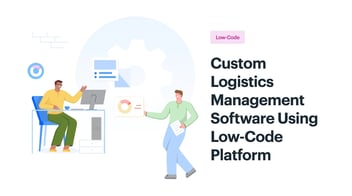
- >
- Low-Code Platform >
- Low-Code vs. RPA: Which One is Right for Your Business?
Low-Code vs. RPA: Which One is Right for Your Business?
The growing need for speed and agility in today’s highly competitive business landscape has driven many businesses to adopt automation solutions for their day-to-day operations. As of 2020, 36 percent of organizations already used business process management software to automate their workflows. 50 percent of business leaders plan to automate repetitive tasks within their organization.
Market Research Future projects that the global automation market will reach $214.64 billion by 2025, with a cumulative annual growth rate of 6.6 percent from 2020 to 2025.
More than just digitizing business assets or adopting new tools and technologies, businesses that aim to work faster and more efficiently must streamline and automate their business processes to stay competitive.
One common approach enterprises use to automate their simple, repeatable tasks is Robotic Process Automation. It is one of the leading automation trends, with up to 65 percent of global enterprises adopting RPA in 2023.
An alternative approach is to use a low-code platform to power automation. While these two technologies offer similar promise in terms of their capabilities and use cases, they have remarkable differences.
Understanding their differences and similarities is critical to choosing the right automation tool. Let’s explore the concept of low-code and RPA to understand their main benefits and when to use one over the other.
For how enterprises turn that mandate into outcomes, see Low-code Digital Automation – The Future tech for Enterprise Businesses
Learn more: What is Enterprise Application Modernization - An Ultimate Guide in 2025
Demystifying low-code and RPA
Low-code is primarily a visual approach to software development but can also be used to automate business processes. Low-code development allows you to build complex enterprise applications with minimal manual coding.
Instead of writing software code line by line, this development approach lets you build apps like you’re drawing a flowchart using a drag-and-drop interface. It makes building new apps quicker and more intuitive than traditional development.
Using the low-code approach, enterprises can design business solutions to streamline and automate repeatable tasks, complex workflows, and end-to-end processes.
See shop-floor use cases and templates in Low-Code Platform For Manufacturing Industry Process Automation
On the other hand, RPA is an approach to business process automation that involves building self-learning virtual bots to handle repetitive tasks. These bots are programmed to follow predefined rules and trigger actions ‘if’' specific conditions are met.
RPA bots mimic the interaction between human users and other software systems. Automating repetitive tasks like moving files or folders, copying and pasting data, filling out forms, and so on is possible. RPA finds application in many repetitive task-based processes across industries like banking, insurance, utilities, and telecommunications.
Learn more: What is the Future of Low code development
Experience the power of low-code with the simplicity of no-code.
How does Low code differ from RPA?
|
Low code
|
RPA
|
|
Optimizes and speeds up application development. |
Uses structured inputs and business logic to automate manual, repetitive processes. |
|
Offers cloud-based services and integrations that help organizations scale without risking quality. |
Requires significantly more time to identify and analyze which processes need to be automated. |
|
Allows business users to build comprehensive applications. |
Builds a system that mimics human actions with speed and predictability. |
|
Promotes productivity and enables users to turn ideas into solutions. |
Great for organizations running legacy applications looking to transform digital process flows. |
Key advances in the low code market
According to a survey, two-thirds of large enterprises will use at least four low-code applications by 2024. The rapid adoption can be partly attributed to critical advancements in low-code technology, making this approach to automation more powerful and versatile.
Compare capabilities against custom builds in Low-Code vs Traditional Software Development.
Some of these advancements include:
- AI-powered development tools
Recent development has seen a growing integration of Artificial Intelligence (AI) features into low-code development platforms. Features like natural language processing, predictive analysis, and automated testing streamline the development process and improve decision-making of low-code automation solutions. As AI technology advances, we can expect an even deeper integration of AI in low-code, allowing low-code developers to create more sophisticated automation applications with minimal effort. - Cloud-native capabilities
Low code platform are becoming increasingly cloud native. Most apps developed with low-code no-code platforms are designed to run on the cloud and integrate with other cloud-native applications. The growing cloud-native capabilities of low-code automation allow enterprises to deploy and manage their low-code applications at scale, increasing accessibility and agility. - Integration with enterprise systems
Low-code platforms can integrate with existing enterprise systems such as Customer Relationship Management (CRM) and Enterprise Resource Planning (ERP). Businesses can build end-to-end automated systems that connect with their existing application landscape without writing complex code.
For a practical look at combining low-code development with automation, explore this article on Power Automate.
Learn more: A Guide to EHR software development
Limitations of robotic process automation
While RPA has some advantages, these limitations can be a deterrence for forward-looking organizations seeking to thrive in an increasingly digital world:
1. High maintenance
RPA requires regular management, maintenance and security, which adds on to the processes the IT department has to tackle. The more bots your organization deploys to automate processes, the more the likelihood of your IT department being overwhelmed. Since RPA requires integration into the corporate IT infrastructure, it adds a layer of architectural complexity, and IT overhead. IT personnel have to ensure your RPA bots are working optimally and simultaneously manage other IT processes.
2. Successive changes break processes
RPA is limited to individual tasks and cannot adapt to change. Software bots are trained to follow specific, straightforward actions, so even minor updates to the user interface or underlying systems can cause processes to fail, or return incorrect data. Any exceptions outside predefined procedures can confuse bots, make the automation process brittle, halt RPA processes and require complete re-tuning.
3. Move the focus away from strategic projects
RPA is a tactical, relatively easier way to gain swift process efficiency, but it may unintentionally divert attention away from more critical and strategic projects. It can also make you overlook digitalization opportunities or take you away from more valuable activities, such as replacing large legacy core systems or creating new systems for disruptive business processes.
4. Cannot interpret unstructured data
RPA is not a cognitive solution for interpreting unstructured data. It's more useful for rule-based processes with set criteria and structured, easy-to-access data entry with well-defined processes. It's best for data stored in a quality standardized format in columns and rows that conforms to a data model. Unfortunately, many business documents have unstructured data such as rich media, images, or text that require a higher level of intelligence.
Learn more: Top 10 low code challenges that can be solved for enterprise
Beyond automation: Innovation and digital transformation
Low-code drives innovation by enabling businesses to reimagine internal processes, create new business models, and achieve digital transformation even with limited resources.
Building with low-code is faster, allowing organizations to innovate quickly and build software to help them compete effectively within their industry. Low-code also bridges the skill gap, one of the main hindrances to digital transformation.
Most organizations lack the talent to go beyond automating their everyday operations. With low-code, business users can build and automate workflows without needing help from the IT department. It reduces the burden on IT and allows them to focus on more complex projects critical to achieving complete digital transformation.
Low-code also makes it easier for businesses to maintain agility, which is necessary to stay ahead of the competition. You can build applications in a few days instead of months, ensuring your business adapts quickly to changing market conditions and consumer behavior.
The low-code edge over RPA
Low code is a practical development platform shaking up the industry. Its diverse benefits give it a definite edge over RPA:
Reduced maintenance
Low code’s simplified development process and ready-to-use templates reduce the need for regular maintenance. It lets your business manage and track development processes across the organization from one central dashboard. It's a comprehensive, end-to-end solution that reduces the number of bugs, and streamlines the automation process, making it stress-free.
More flexibility
Low-code is an innovative and flexible tool that helps businesses scale easily. It allows organizations to fill the IT skills shortage gap with business users who build custom applications, helping the company quickly adapt to ever-changing market requirements and business conditions. It increases retention rates because non-tech users can meet customer needs and enhance customer experiences across all channels without waiting on IT developers.
Enhanced agility
Low code process automation is designed to simplify the exhaustive and time-consuming application development process. You can build and update applications faster and easier, to meet current requirements and changing organizational needs. The little coding knowledge and skills required to build apps, pre-built templates, and automated testing in low-code platforms increases organizational agility.
Greater speed
Low code offers an intuitive and highly visual graphical user interface that uses API connectors to integrate with third-party tools to quicken app development. The time and effort typically required to create enterprise-grade applications with low code are relatively less, whether you’re building apps, completely redesigning processes, or adding features. You’ll deliver apps in days or weeks instead of months.
Cost-effective
Low-code platforms’ initial set-up, training, implementation, and maintenance cost less. Creating custom, fully functional apps and updating them requires little coding skills and takes little time, which saves you time and money. Also, low code has fewer staffing needs and doesn’t require specialized IT skills, so it greatly reduces the need for IT experts. IT developers can automate and refine processes to deliver projects faster, further saving money because fewer developers can handle key non-repetitive IT processes.
Beyond automation: Innovation and digital transformation
Low-code drives innovation by enabling businesses to reimagine internal processes, create new business models, and achieve digital transformation even with limited resources.
Building with low-code is faster, allowing organizations to innovate quickly and build software to help them compete effectively within their industry. Low-code also bridges the skill gap, one of the main hindrances to digital transformation.
Most organizations lack the talent to go beyond automating their everyday operations. With low-code, business users can build and automate workflows without needing help from the IT department. It reduces the burden on IT and allows them to focus on more complex projects critical to achieving complete digital transformation.
Low-code also makes it easier for businesses to maintain agility, which is necessary to stay ahead of the competition. You can build applications in a few days instead of months, ensuring your business adapts quickly to changing market conditions and consumer behavior.
.webp?width=260&height=260&name=Building%20Custom%20Enterprise%20apps%20(1).webp)
Building Custom Enterprise Applications on a Low-Code Platform
Thank you for downloading!
RPA or low-code solutions: Which is better for enterprise business?
RPA is an efficient way to automate repetitive business tasks for greater efficiency. Low-code offers the same benefits but provides a broader range of development capabilities that help redesign entire processes to fix the core inefficiencies. Low-code is a better choice for process automation, especially for businesses looking to automate workflows, streamline operations, and accelerate digital transformation.
Take Caratlane, for instance; India’s first omnichannel jewelry brand founded to make jewelry accessible, affordable, and forever wearable for its customers. Despite a partnership with India’s largest retail jeweler, Tanishq, to offer a distinctive shopping experience to customers, Caratlane struggled with a poor and messy post-order process.
Most tasks were handled with forms and spreadsheets, making them tedious and challenging to track. The company needed a custom solution to effectively clean up its operations and digitalize processes.
As both low-code and no-code markets continue to expand rapidly, it's important to understand the difference between low-code and no-code platforms and how each contributes to digital transformation strategies.
In 2017, Caratlane adopted Kissflow as the low-code/no-code platform for automating workflows, managing business processes, and building enterprise applications.
With Kissflow, Caratlane created apps for its warehousing, accounting, customer service, quality checks, and other vital departments in a fraction of time. It led to a boost in customer satisfaction and accountability, accelerating innovation without IT dependency.
Low-code over RPA every time
RPA may be easier to implement, but it's slowly dying. Switching to Kissflow low-code moves you to a more sustainable and adaptive platform that increases business agility, integrates easily with remote solutions, and will help you innovate frequently. It's a cloud-driven solution to help you implement a better digital transformation strategy and meet changing business and customer needs.
Kissflow Low-Code Development Platform
Get in touch with us to learn more about how you can transform your application needs.
Related Articles











